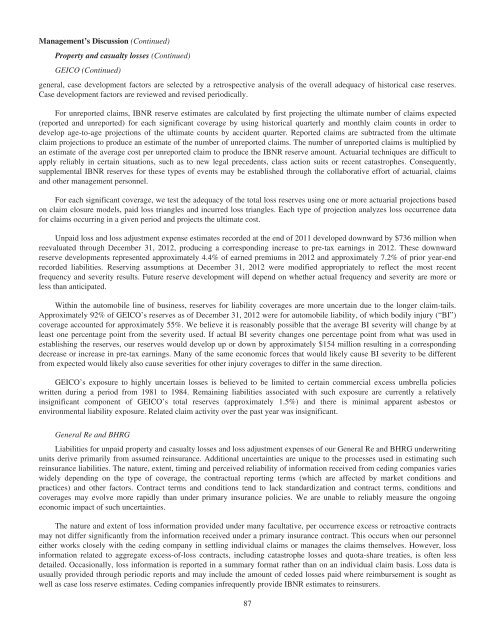BERKSHIRE HATHAWAY
BERKSHIRE HATHAWAY
BERKSHIRE HATHAWAY
Create successful ePaper yourself
Turn your PDF publications into a flip-book with our unique Google optimized e-Paper software.
Management’s Discussion (Continued)<br />
Property and casualty losses (Continued)<br />
GEICO (Continued)<br />
general, case development factors are selected by a retrospective analysis of the overall adequacy of historical case reserves.<br />
Case development factors are reviewed and revised periodically.<br />
For unreported claims, IBNR reserve estimates are calculated by first projecting the ultimate number of claims expected<br />
(reported and unreported) for each significant coverage by using historical quarterly and monthly claim counts in order to<br />
develop age-to-age projections of the ultimate counts by accident quarter. Reported claims are subtracted from the ultimate<br />
claim projections to produce an estimate of the number of unreported claims. The number of unreported claims is multiplied by<br />
an estimate of the average cost per unreported claim to produce the IBNR reserve amount. Actuarial techniques are difficult to<br />
apply reliably in certain situations, such as to new legal precedents, class action suits or recent catastrophes. Consequently,<br />
supplemental IBNR reserves for these types of events may be established through the collaborative effort of actuarial, claims<br />
and other management personnel.<br />
For each significant coverage, we test the adequacy of the total loss reserves using one or more actuarial projections based<br />
on claim closure models, paid loss triangles and incurred loss triangles. Each type of projection analyzes loss occurrence data<br />
for claims occurring in a given period and projects the ultimate cost.<br />
Unpaid loss and loss adjustment expense estimates recorded at the end of 2011 developed downward by $736 million when<br />
reevaluated through December 31, 2012, producing a corresponding increase to pre-tax earnings in 2012. These downward<br />
reserve developments represented approximately 4.4% of earned premiums in 2012 and approximately 7.2% of prior year-end<br />
recorded liabilities. Reserving assumptions at December 31, 2012 were modified appropriately to reflect the most recent<br />
frequency and severity results. Future reserve development will depend on whether actual frequency and severity are more or<br />
less than anticipated.<br />
Within the automobile line of business, reserves for liability coverages are more uncertain due to the longer claim-tails.<br />
Approximately 92% of GEICO’s reserves as of December 31, 2012 were for automobile liability, of which bodily injury (“BI”)<br />
coverage accounted for approximately 55%. We believe it is reasonably possible that the average BI severity will change by at<br />
least one percentage point from the severity used. If actual BI severity changes one percentage point from what was used in<br />
establishing the reserves, our reserves would develop up or down by approximately $154 million resulting in a corresponding<br />
decrease or increase in pre-tax earnings. Many of the same economic forces that would likely cause BI severity to be different<br />
from expected would likely also cause severities for other injury coverages to differ in the same direction.<br />
GEICO’s exposure to highly uncertain losses is believed to be limited to certain commercial excess umbrella policies<br />
written during a period from 1981 to 1984. Remaining liabilities associated with such exposure are currently a relatively<br />
insignificant component of GEICO’s total reserves (approximately 1.5%) and there is minimal apparent asbestos or<br />
environmental liability exposure. Related claim activity over the past year was insignificant.<br />
General Re and BHRG<br />
Liabilities for unpaid property and casualty losses and loss adjustment expenses of our General Re and BHRG underwriting<br />
units derive primarily from assumed reinsurance. Additional uncertainties are unique to the processes used in estimating such<br />
reinsurance liabilities. The nature, extent, timing and perceived reliability of information received from ceding companies varies<br />
widely depending on the type of coverage, the contractual reporting terms (which are affected by market conditions and<br />
practices) and other factors. Contract terms and conditions tend to lack standardization and contract terms, conditions and<br />
coverages may evolve more rapidly than under primary insurance policies. We are unable to reliably measure the ongoing<br />
economic impact of such uncertainties.<br />
The nature and extent of loss information provided under many facultative, per occurrence excess or retroactive contracts<br />
may not differ significantly from the information received under a primary insurance contract. This occurs when our personnel<br />
either works closely with the ceding company in settling individual claims or manages the claims themselves. However, loss<br />
information related to aggregate excess-of-loss contracts, including catastrophe losses and quota-share treaties, is often less<br />
detailed. Occasionally, loss information is reported in a summary format rather than on an individual claim basis. Loss data is<br />
usually provided through periodic reports and may include the amount of ceded losses paid where reimbursement is sought as<br />
well as case loss reserve estimates. Ceding companies infrequently provide IBNR estimates to reinsurers.<br />
87


